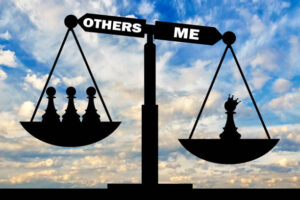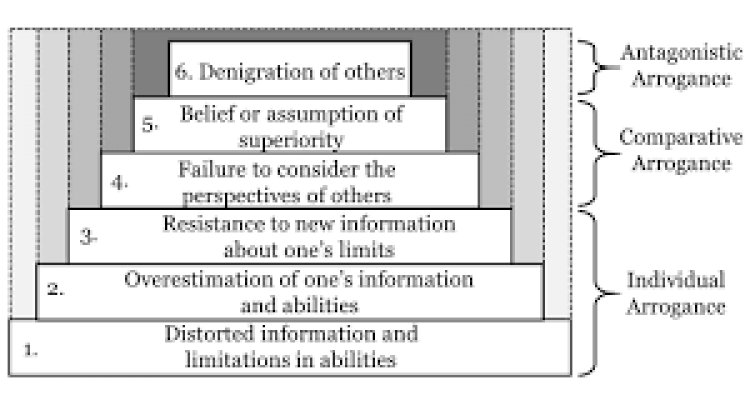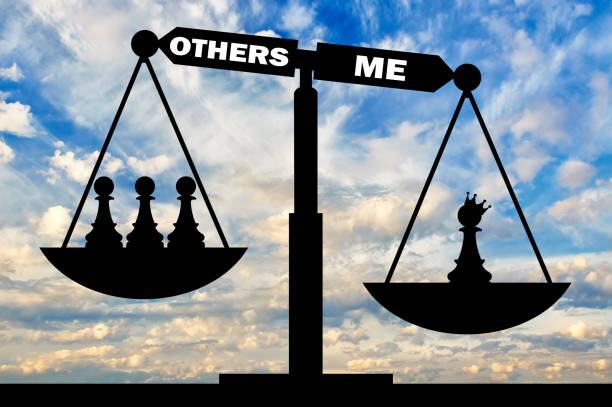
Arrogance means “bigging yourself up”—whether publicly or just inside your own mindAs with the opposite chief feature of self-deprecation, arrogance is a way of manipulating others’ perceptions of yourself in order to avoid taking a “hit” to your self-esteem. In this case, however, the basic strategy is to get others to see you as special, perfect or flawless — diverting attention from your ordinary imperfections, weaknesses and failings — and thereby keeping your self-esteem artificially inflated.
What is arrogance?
Arrogance means “bigging yourself up”—whether publicly or just inside your own mind. Often it involves knocking others down at the same time.
It is generally defined as:
The act or habit of making undue claims in an overbearing manner;
that species of pride which consists in exorbitant claims of rank, dignity, estimation, or power, or which exalts the worth or importance of the person to an undue degree;
proud contempt of others. [1]
Other names for arrogance are: egotism, conceit, grandiosity, and self-importance.
Ancient Greek literature refers to hubris, a form of arrogance in which a person thinks himself to be higher in status than other ordinary mortals. In other words, a god.
Types of Arrogance
The guy down the hall from you might be an arrogant jerk — but what kind of arrogant jerk? There are three types of arrogance, according to a new literature review team of psychology researchers at the University of Missouri-Columbia, and they broke them down into “levels.”
Nelson Cowan, a Curators Distinguished Professor of Psychological Sciences in the MU College of Arts and Science, led the study.
“We were surprised at the limited amount of modern research we found on arrogance,” Cowan said in a release of the group’s findings. “Furthermore, we found it didn’t all come from one specific area. So we created a one-stop resource to inspire further research, including, but not limited to, possible medical diagnoses of personality disorders.”
There are three distinct types of arrogance, according to Cowan and his team.
- Individual arrogance: This might be the most familiar type. An outsized opinion of one’s own abilities or accomplishments, this person could be your Saturday night date or your boss. It can be annoying, but it’s largely harmless.
- Competitive arrogance: This person has an exaggerated sense of their own abilities or accomplishments as compared to others. If they’re a tennis player, for example,they probably think they could give Venus Williams a run for her money on the court.
- Antagonistic arrogance: This type is probably the most serious; the type of person who enjoys the “denigration of others based on an assumption of superiority.” The antagonistically arrogant person shows or feels “active opposition or hostility” towards someone or something,” suggesting their aggression

Components of arrogance
Like all chief features, arrogance involves the following components:
- Early negative experiences
- Misconceptions about the nature of self, life or others
- A constant fear and sense of insecurity
- A maladaptive strategy to protect the self
- A persona to hide all of the above in adulthood
Generally speaking, the advice goes that, if you’re kind and respectful to others, your positive behavior will pay off and you’ll find success. But as life already might have shown you, arrogant people are everywhere. They don’t always play nice, and unfortunately, that can let them snatch what you want and deserve right out from under you. How is it that such a stinky trait lets them squish you with their thumbs?
In an article for Psychology Today, Dr. Glenn Geher, professor of psychology at State University of New York at New Paltz, explains how arrogance can hold advantages.
1. Arrogant people aren’t afraid to spew angry venom or attack others. Arrogant people tend to express their anger and make fights personal relatively easy. It takes a great deal of emotional intelligence to defend yourself without making this kind of situation worse, and many people are so shocked by the attacks that, because of the way stress shuts down the logic centers of the brain, they have trouble responding at all.
2. Arrogant people are a challenge. Arrogant people tend to score low on agreeableness on personality tests. They have no problem stubbornly promoting themselves and resisting the proposals of others, even if they do so in a “polite” way. This ego-based resistance is exhausting to others.
3. Arrogant people believe they are (and enjoy being) superior. Even as arrogant people score low on personality tests for agreeableness, they score higher on measures of feeling superior, as well as on measures of social dominance. Their feelings of being a level up from others supports them in different ways, such as giving them the confidence to take more risks or even looking more attractive to potential romantic partners
Early Negative Experiences
In the case of arrogance, the early negative experiences typically consist of disapproval or outright criticism from significant others, especially the parents but also siblings and others.
All infants are born with a natural desire for love, care and attention. Ideally, these are readily available and given unconditionally. Generally, though, life is imperfect and young children experience some degree of harshness or deprivation in their upbringing.
An infant believes the world revolves around him. It’s all about me. This is quite normal, and the average child will move beyond that stage by recognizing that they are a part of a family, that there are others in the world, and that it is better to consider what others want rather than be completely self-centered.
In some cases, though, a child can get stuck in needing to put me first. Sometimes, a child’s ability to receive love, care, attention, etc. has to be competed for and is conditional upon her being a certain way and/or not being some other way. Alternatively, she may receive equal measures of love and antagonism, or care and neglect, or attention and abandonment. She will then want to figure out which aspects of herself trigger which reactions.
Perhaps the most typical scenario is one of sibling rivalry, where the children must compete for the parents’ attention, approval and affection. Children in this kind of set-up soon realise that the rewards and punishments given out by their parents are a direct result of how the parents perceive their children—and those perceptions can be manipulated.
The way to compete, then, is to manipulate the parents’ perceptions by highlighting or exaggerating the other kids’ faults while apparently being “the good one”.
All of this, of course, is a very common childhood experience—which is why arrogance is a very common character flaw.
Misconceptions
From such experiences of competition, disapproval and conditional love, the child comes to perceive her well-being as dependent upon others’ perceptions:
My well-being in life depends upon how others see me.
Fear
As a result of this misconception, the child becomes gripped by an entrenched fear of her vulnerability to negative perceptions—
Being vulnerable to any kind of criticism or disapproval is bad for me.
Any perceived weakness, failing or imperfection in me is contemptible and unacceptable.
If I show any of my real weaknesses, failings or imperfections, it could be disastrous.
Hence, showing vulnerability in the eyes of others becomes unacceptable and frightening.
Strategy
The basic strategy for coping with this fear of vulnerability to others’ perceptions is to manipulate others’ perceptions—to ensure that there is never anything for them to disapprove of or criticise.
I must draw attention only to my winning qualities.
I must never show my real self, which I know to be imperfect and weak and flawed.
I must always appear to be “better” in some way than my rivals.
Typically this involves:
- drawing attention to and exaggerating one’s own strengths, successes and specialness while diminishing, hiding and denying one’s own weaknesses, failings and ordinariness;
- drawing attention to and exaggerating others’ weaknesses, failings and ordinariness while diminishing, hiding and denying their strengths, successes and specialness.
The most primitive form of this is blatant, shameless boastfulness combined with outright derision of others to their faces. “I’m better than you, so there.” The individual hopes that if she says it often enough the world will just agree and there will be no more competition. This is impossible, of course.
Persona
It is unacceptable to be too obviously arrogant and manipulative in most adult settings. Just going around bragging is “against the rules” in most social circles — though a number of rap artists make a good living out of expressing this form of arrogance.
A more subtle form of the arrogance strategy is to point to evidence which, hopefully, will lead others to reach the right conclusion by themselves. Hence the chief feature of arrogance puts on a mask which quietly says to the world, “I’m not being arrogant. I’m not saying I’m better than you. It’s just that…” Arrogance keeps up the same message, typically by telling true stories which indirectly convey yet more evidence of one’s own specialness and wonderfulness. “I’ve had such a hard day! Silly people won’t stop calling me just to say how much they like my new book.”
There is no better lie than a lie based on truth. The mask of arrogance likes to surround itself with “truths” which reinforce the image of invulnerability.
And if the individual should find himself in an actual position of superior status or power, the chief feature goes to town. In his book The Hubris Syndrome: Bush, Blair and the Intoxication of Power the British politician David Owen argues that President George W. Bush and Prime Minister Tony Blair developed a “Hubristic Syndrome” while in power, particularly in their handling of the Iraq War.
All people are capable of this kind of behaviour. When it dominates the personality, however, one is said to have a chief feature of arrogance.
Positive and Negative Poles
Arrogance, like all character flaws, is inherently negative. Nevertheless, it still has the potential for a positive outcome.
The positive outcome of arrogance is PRIDE, while the more negative outcomes can be referred to as VANITY.
+ pride +
|
ARROGANCE
|
– vanity –
Pride is a state of self-esteem and perceived self-worth which may or may not be exaggerated. Ideally, it is a state in which you recognise your own good qualities in their own right, rather than exaggerating your good qualities to mask or deny your vulnerabilities.
The development of positive self-esteem must focus on lasting and enduring qualities. It must consider uniqueness as opposed to specialness.
Carolyn Warnemuende, Self-esteem or narcissism?
Vanity is a state of excessive, unjustified pride—an obsessive tendency to compare oneself favourably against others, or to regard one’s own positive abilities or attractiveness as evidence of being above the common herd. This can manifest as egotism: constantly acting out of an inflated sense of self; it can also manifest as narcissism: treating others as nothing but mirrors whose job is to affirm one’s superiority.
In Biblical terms, vanity was often symbolized by the Whore of Babylon. During the Renaissance, vanity was represented as a naked woman combing her hair in front of a mirror held by a demon or cherub. An alternative symbol of preening vanity is the peacock.
The term vanity originates from the Latin word vanitas meaning emptiness, untruthfulness, futility, foolishness. The phrase Omnia Vanitas (“All is Vanity”) refers to the ultimate futility of our self-centered efforts in this world. This aspect of vanity (as the displacement of spiritual concerns with material concerns) is often symbolized in art by the image of a skull.

… unhealthy self-esteem, as in narcissism, refers to insensitivity to others, with excessive preoccupation with the self and one’s own image and appearance in the eyes of others.
Dr. Lilian Katz (Distinctions between Self-Esteem and Narcissism)
While most people possess some degree of narcissistic traits, extreme levels of narcissism can be dysfunctional and may be classified as narcissistic personality disorder.
At Positive Psychology and Educational Consult, we are ready to help you to navigate your life. Contact us today. We are available online 24/7.
Phone: +2348034105253. Email: positivepsychologyorgng@gmail.com twitter: @positiv92592869. facebook: positive.psych.12
